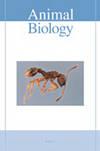生物和非生物应激源对两种同域蜥蜴不对称和头部大小的影响
IF 0.9
4区 生物学
Q2 ZOOLOGY
引用次数: 1
摘要
生物体面临许多环境压力,这些压力会影响发育精度,包括各种物理特征的对称性。因此,波动不对称性(FA)被认为是评估亚致死压力水平的一种简单有效的工具。我们分析了两种同域蜥蜴(Iberolacerta horvathi和Podarcis muralis)的FA,以确定种间竞争和城市化的潜在影响,作为压力的指标,同时考虑到两性异形和环境条件。我们对16个同位和异位种群进行了采样,并使用了头部形态的几何形态计量学。我们检测到环境和物种间不同的同位发生对头部不对称性的显著但混合的影响。P.muralis蜥蜴在高海拔地区有更多不对称的头部,而I.horvathi蜥蜴在中海拔地区有,这可能是因为P.murali在高海拔经历了寒冷条件下的环境压力。中海拔对I.horvathi不对称性的影响可能是由于石壁的可用性较低和P.muralis的丰度较高,因此竞争更激烈。髂上颗粒的不对称性受到其他物种存在的影响。然而,与同期种群的蜥蜴相比,同种种群的蜥蜴获得了更大的不对称性,这与预期相反。muralis没有受到城市化的影响,这可能是由于研究地点的污染相对较低和栖息地退化。总的来说,我们强调了使用蜥蜴和FA进行环境应激源生物指示的可能性,特别是改善了生物应激源研究中的知识差距。本文章由计算机程序翻译,如有差异,请以英文原文为准。
Effects of biotic and abiotic stressors on asymmetries and head size in two sympatric lizard species
Organisms face numerous environmental stressors, which can affect developmental precision, including symmetry of various physical characteristics. Fluctuating asymmetry (FA) has therefore been suggested as a simple and efficient tool for assessing sub-lethal stress levels. We analyzed FA in two sympatric lizard species (Iberolacerta horvathi and Podarcis muralis) to determine potential effects of interspecific competition and urbanization, as proxies of stress, taking into account sexual dimorphism and environmental conditions. We sampled 16 syntopic and allotopic populations and used geometric morphometrics of head morphology. We detected significant but mixed effects on the head asymmetry from the environment and the syntopic occurrence that differed between species. P. muralis lizards had more asymmetric heads at higher altitudes, while I. horvathi lizards did at mid altitudes, which may be explained by P. muralis experiencing environmental stress of colder conditions at higher altitudes. The mid-altitude effect on asymmetries in I. horvathi might be explained by a lower availability of stony walls and higher abundance of P. muralis, thus higher competition. The asymmetry of supraciliary granules was affected by the presence of other species. However, lizards from allotopic populations attained larger asymmetries compared to lizards from syntopic populations, which was the opposite from what was expected. There was no effect of urbanization in P. muralis, which could be due to relatively low pollution and habitat degradation in study locations. Overall, we highlighted the possibility of using lizards and FA for bioindication of environmental stressors and especially improved the knowledge gap in the research of biotic stressors.
求助全文
通过发布文献求助,成功后即可免费获取论文全文。
去求助
来源期刊

Animal Biology
生物-动物学
CiteScore
2.10
自引率
0.00%
发文量
34
审稿时长
3 months
期刊介绍:
Animal Biology publishes high quality papers and focuses on integration of the various disciplines within the broad field of zoology. These disciplines include behaviour, developmental biology, ecology, endocrinology, evolutionary biology, genomics, morphology, neurobiology, physiology, systematics and theoretical biology. Purely descriptive papers will not be considered for publication.
Animal Biology is the official journal of the Royal Dutch Zoological Society since its foundation in 1872. The journal was initially called Archives Néerlandaises de Zoologie, which was changed in 1952 to Netherlands Journal of Zoology, the current name was established in 2003.
 求助内容:
求助内容: 应助结果提醒方式:
应助结果提醒方式:


